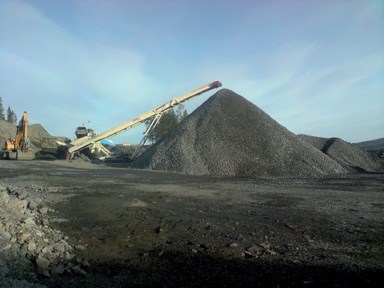Management of Tips and Stockpiles
It is important to remember that the legal term ‘tip’ includes stockpiles. These can be as hazardous as other tips, and so they too need to be properly designed and operated. Walls or other supports provided to contain stockpiles should be designed by a competent person and considered as part of the stockpile during appraisal or assessment. The Operator must ensure that suitable operating procedures are in place for the safe operation of tips and stockpiles: The operating procedures for tips should also address, in the case of solid tips: - The degree of compaction required for tipped material.
- The frequency of inspection, appraisal and assessment,
|  |
Factors determining the siting and design of tips and stockpiles
- The nature of the quarried material. –unstable materials do not compact to form a stable surface and are more likely to fail or flow– stable materials compact to form a stable surface. – Stable materials can become unstable if one or more of the other factors below are causing an issue.
- The ground used for the stockpiles- It should be firm and provide a stable foundation. It should be relatively level, properly drained and should not be affected by water courses, which may flood.
- The volume of product. - The output of a quarry will have an influence on the siting, type and size of stockpile. The angle of repose of the stockpiled material must be taken into account
- The area available and required. - The size of the area, irrespective of the type of stockpile, must be sufficient for mobile equipment to operate when dumping and loading out.
- Other potential hazards. - No stockpile should be formed under or on top of power lines. Access shall not be from beneath overhead power lines. High stockpiles should not be located where high wind conditions may suddenly occur.
- Environmental considerations. - Siting should ensure the lowest environmental impact possible.
The potential failure of a tip or stockpile can be influenced by:
- The material being stockpiled
- The configuration and placement of the tip/stockpile
- The mobile equipment being used
- The immediate and overhead environment
- The degree of moisture and drainage of the tip/stockpile
- The method of material retrieval,
Forming the Tip/stockpile:
Access ramps:
- Access must be sited to avoid the possibility of impact with other mobile equipment.
- The ramp should be constructed using a front end loader, bulldozer or other suitable ma-chine and adequately compacted.
- The ramp angle should be such that it is compatible for the safe use of the appropriate mobile equipment.
- Bunds should be constructed at the edges.
Initial tipping or dumping:
The lead up to the edge should be compacted and have an upward run to the tipping point. At the sides of the approach and at the tipping point, a bund is to be formed at least the height of the axle of the vehicle used, with the width a minimum of twice the height.
The machine or equipment used to keep the ‘tip-head’ cleared – the operator should always ensure that they maintain a bund at the ‘tip-head that will prevent the inadvertent movement of vehicles over the face.
Operating the stockpile/Tip:
The methods of tipping after the stockpile is initially formed will depend on the nature of the material being stockpiled.
Instability of the Stockpile/Tip:
- Simultaneous loading and stockpiling / tipping in the same area of a stockpile should is to be avoided where possible or tipping should be carried out at a safe distance from where the loading is being performed.
- When loading from stockpiles takes place, vehicle access to tip on the same stockpile should be prevented e.g. by removing the ramp, or tipping loads across the ramp
- Where there is a high risk of instability, a suitably instructed ‘spotter’ should be used.
- Non-operational areas, unstable surfaces or edges should be isolated to prevent unauthorized access.
- Consideration should be given to the benching of stockpiles of sub-bases, dust, scalpings etc., which might ‘hang up’ during placement or subsequent excavation and/or loading
- The impact on stockpile stability of discharges of water e.g. from a blocked sand classifier or as a result of excessive rainfall must always be taken to account.
- For areas of high rainfall special attention should be paid to the construction an effective water ‘run-off’ and collection system. Culverts and water tables designed and constructed with excess capacity to cope with the heaviest of rainfall periods. The operator should arrange additional special inspections after heavy or prolonged rain
Quarry face tipping:
The hazards are the same as for other tipping. The risk of serious injury is greater because of the acute angle and height of the face. Recommended practices are as follows:
- The ground at the edge of the face should be inspected before tipping operations commence.
- The location of operation will be designated.
- The initial tipping should not be directly over the edge.
- The initial operations should be directly observed by a second competent person and they should inspect the face and bench after each tipping.
- Mobile equipment should not be permitted to approach the stockpile below until approved by the manager, or the person in charge
Additional information on the safety of stockpiles, tips and lagoons can be found in Part 6 of the SAFE QUARRY GUIDELINES TO THE SAFETY, HEALTH AND WELFARE AT WORK (QUARRIES) REGULATIONS 2008.